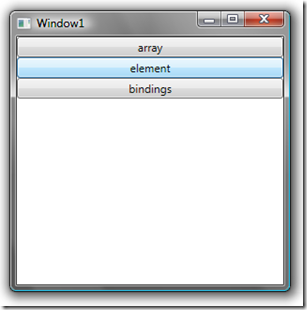Well, I had a great day yesterday, and quite a surprising one. I had an issue with an idea I was working on, so naturally I turned to Josh Smith.
And guess what I, yes me, the mere mortal managed to teach Josh something about WPF…Ha Ha, check that.
So here is what I taught Josh…..(still can't believe I managed to teach Josh something  )
)
I want to be able to bind multiple controls that are all stand alone controls to a collection. Sounds simple enough, right.
Check this code behind:
1: using System;
2: using System.Collections.Generic;
3: using System.Collections.ObjectModel;
4: using System.Linq;
5: using System.Text;
6: using System.Windows;
7: using System.Windows.Controls;
8: using System.Windows.Data;
9: using System.Windows.Documents;
10: using System.Windows.Input;
11: using System.Windows.Media;
12: using System.Windows.Media.Imaging;
13: using System.Windows.Navigation;
14: using System.Windows.Shapes;
15:
16: namespace WPF_test
17: {
18: public partial class Window1 : Window
19: {
20: public ObservableCollection<string>
21: MyValues { get; private set; }
22:
23: public Window1()
24: {
25: MyValues = new ObservableCollection<string>();
26: MyValues.Add("array");
27: MyValues.Add("element");
28: MyValues.Add("bindings");
29:
30:
31: this.DataContext = MyValues;
32: InitializeComponent();
33: }
34:
35: private void Button_Click_0(
36: object sender, RoutedEventArgs e)
37: {
38: MyValues.Clear();
39: MyValues.Add("bindings");
40: MyValues.Add("element");
41: MyValues.Add("array");
42: }
43:
44: private void Button_Click_1(
45: object sender, RoutedEventArgs e)
46: {
47: MyValues.Clear();
48: MyValues.Add("element");
49: MyValues.Add("bindings");
50: MyValues.Add("array");
51: }
52:
53: private void Button_Click_2(
54: object sender, RoutedEventArgs e)
55: {
56: MyValues.Clear();
57: MyValues.Add("array");
58: MyValues.Add("bindings");
59: MyValues.Add("element");
60: }
61: }
62: }
And here is the XAML code. This is where the individual elements are bound to the MyValues collection. Let's see:
1: <Window x:Class="WPF_test.Window1″
2: xmlns="http://schemas.microsoft.com/winfx/2006/xaml/presentation"
3: xmlns:x="http://schemas.microsoft.com/winfx/2006/xaml"
4: Title="Window1″ Height="300″ Width="300″>
5:
6:
7: <Window.Resources>
8: <ContentPresenter x:Key="cont1″ Content="{Binding Path=.[0], Mode=OneWay}"/>
9: <ContentPresenter x:Key="cont2″ Content="{Binding Path=.[1], Mode=OneWay}"/>
10: <ContentPresenter x:Key="cont3″ Content="{Binding Path=.[2], Mode=OneWay}"/>
11: </Window.Resources>
12:
13: <StackPanel Orientation="Vertical">
14: <Button Content="{DynamicResource cont1}" Click="Button_Click_0″/>
15: <Button Content="{DynamicResource cont2}" Click="Button_Click_1″/>
16: <Button Content="{DynamicResource cont3}" Click="Button_Click_2″/>
17: </StackPanel>
18:
19:
20: </Window>
And real guts of this post is the Content=”{Binding Path=.[0], Mode=OneWay}” part, see how it uses the . notation, which means current Binding, and the [0] indexer.
Neat, huh? And here it is running:

You can see a demo project here.
I currently hold the following qualifications (amongst others, I also studied Music Technology and Electronics, for my sins)
- MSc (Passed with distinctions), in Information Technology for E-Commerce
- BSc Hons (1st class) in Computer Science & Artificial Intelligence
Both of these at Sussex University UK.
Award(s)
I am lucky enough to have won a few awards for Zany Crazy code articles over the years
- Microsoft C# MVP 2016
- Codeproject MVP 2016
- Microsoft C# MVP 2015
- Codeproject MVP 2015
- Microsoft C# MVP 2014
- Codeproject MVP 2014
- Microsoft C# MVP 2013
- Codeproject MVP 2013
- Microsoft C# MVP 2012
- Codeproject MVP 2012
- Microsoft C# MVP 2011
- Codeproject MVP 2011
- Microsoft C# MVP 2010
- Codeproject MVP 2010
- Microsoft C# MVP 2009
- Codeproject MVP 2009
- Microsoft C# MVP 2008
- Codeproject MVP 2008
- And numerous codeproject awards which you can see over at my blog
 General
General  News
News  Suggestion
Suggestion  Question
Question  Bug
Bug  Answer
Answer  Joke
Joke  Praise
Praise  Rant
Rant  Admin
Admin 






